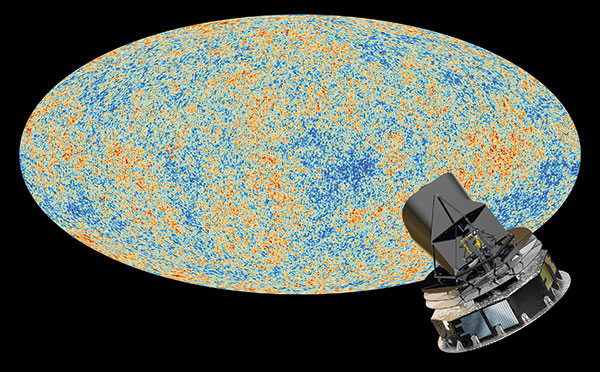 |
WordExplain by James T. Bartsch |
|
"In the beginning, God created the heavens and
the earth." Genesis 1:1
"Then God said, 'Let there be light.' And there was light." Genesis 1:3 |
|
                   |
Does the Cosmic
Microwave Background Confirm the Big Bang?
This
article is a brief summary of and commentary on an Institute for Creation Research article by Jake
Hebert bearing the same title.
There are three main arguments
used to defend the "Big Bang" model of the origin of the universe.
(1) It appears the universe is expanding. Cosmologists affirm this
because of the redshift of galaxies.
(2) The Big Bang can account for the abundance of helium and hydrogen. (3) Cosmic Microwave Background (CMB) electromagnetic radiation is a predictable remnant of the Big Bang.
This article will focus on point 3, the nature of CMB.
The Big Bang model assumes there are no special places or directions in the universe. It assumes CMB radiation should be evenly dispersed in all directions. Astrophysicists use the words "homogenous" and "isotropic." Generally speaking, that is what we find. The "temperature" of space is, in the main, uniform. But that is a problem for the Big Bang. Because the universe is so vast (a radius of 13.8 billion light years), there has not been enough time for the temperature of the universe, at the speed of light, to reach a uniform stage after the initial explosion. This problem is known as the horizon problem. To counteract this problem, secular cosmologists invented "cosmic inflation." They opined that, shortly after the Big Bang, the universe itself underwent a huge growth spurt, expanding faster than the speed of light! According to them, before inflation, space was small enough to achieve a uniform temperature. Radiant temperature warmed up the cool spots. After uniformity was achieved, the universe miraculously expanded faster than the speed of light! The difficulty is that there is no direct evidence of inflation. Supposed evidence was quickly retracted in 2014. But other problems persist. There should not be large patches of the universe that show even slight temperature differences. Cosmologists call these temperature anisotropies (differences). But there are large patches of both warm and cool anisotropies (see the figure at the top of the page). One of them is called "the cold spot." This is very troubling to astrophysicists. Worse yet to secular cosmologists, some of these large-scale temperature differences in the CMB appear to be aligned with our solar system! Some have even called this unexpected discovery "the axis of evil!" This correlation is unthinkable, because to the secular cosmologist, there is nothing special about our solar system or our earth. According to Lawrence Kraus: But when you
look at CMB map, you also see that the structure that is observed, is
in fact, in a weird way, correlated with the plane of the earth around
the sun. Is this Copernicus coming back to haunt us? That’s crazy.
We’re looking at the whole universe. There’s no way there
should be a correlation of structure with our motion of the earth
around the sun—the plane of the earth around the sun—the ecliptic. That
would say we are truly the center of the universe.
Of course, we Biblical Creationists have no trouble believing that our
earth is the center of the universe. That is exactly the way God
created
it (Gen. 1:1-31)!
To sum up the article on the CMB conundrum, let me quote the conclusion of Jake Hebert: The
successful prediction of the existence of a cosmic microwave background
is arguably the Big Bang’s greatest success, and creation scientists
need to provide a detailed alternative explanation for its existence.
Even so, there are features within the CMB that are completely contrary
to Big Bang expectations. Given that the Big Bang’s strongest argument has these
problems, one can safely conclude that the scientific case for the Big
Bang model is extremely
weak, and no one, especially Christians, should feel compelled to
accept it.
I am not an astrophysicist, but I am a student of the Bible. Under the direction of the Holy Spirit, the Psalmist David declared, in Psalm 19:1-4a The
heavens are telling of the glory of God; and their expanse is declaring
the work of His hands. Day to day pours forth speech, and night to
night reveals knowledge. There is no speech, nor are there words; their
voice is not heard. [Yet], Their line has gone out through all the
earth, and their utterances to the end of the world.
We read that God created the heavens (the universe, or cosmos) and the earth on Day One (Gen. 1:1). The main feature of the entire universe was the earth. On that same day, God also created light (Gen. 1:3). Most of us think only of the visible spectrum of light. But light also exists in other spectra, such as radio waves, microwaves, infrared rays. ultraviolet rays, x-rays, and gamma rays. I believe that God, when He created light, filled the entire universe with Cosmic Microwave Background electromagnetic radiation. And at some point, perhaps on the Fourth Day (Gen. 1:14-19), He tweaked it just a bit so that, as Lawrence Kraus has observed, there is a correlation of CMB temperature structure with the plane of the orbit of our earth around our sun! That, to me, makes far more sense than to posit the explanation that, after the small universe had established a uniform temperature, the whole cosmos miraculously expanded (inflated) faster than the speed of light, a phenomenon no scientist has ever witnessed or measured! and that the correlation of the CMB with the ecliptic of our solar system happened by random chance, a probability that has only 0.1 per cent chance of occurring! Published in WordExplain on
October 8, 2022. Updated on October 11, 2022
Updated on November 19, 2022
|
||
